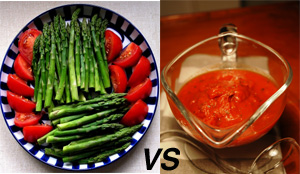 Raw food diets are getting a lot of attention lately, both on this blog and in the wider health community. The raw diet tied for the second best diet for weight loss in U.S. News‘ assessment, and raw cleanses are a hot trend this summer.
Raw food diets are getting a lot of attention lately, both on this blog and in the wider health community. The raw diet tied for the second best diet for weight loss in U.S. News‘ assessment, and raw cleanses are a hot trend this summer.
Supporters of the raw diet believe that raw fruits, vegetables and in some cases meat and dairy are the richest sources of vitamins, minerals, enzymes and other nutrients. While a plant-based raw diet is certainly very healthy, cooking some plants actually increases some nutrients and can also make nutrients more bio-available.
Once you start to look at the question of raw vs. cooked foods, it immediately becomes a complex matter. Nutrition science has become quite sophisticated, yet there’s still only a limited amount of research available on the subject. Some nutrients may be lost during the cooking process yet others are enriched by cooking and exposure to heat. Yet, there are still many gray areas when it comes to the importance of many vitamins, minerals and other phytochemicals. Below are some of the facts that we do have about raw vs. cooked foods, organized by nutrient.
Lycopene
Lycopene is an essential nutrient found in tomatoes, and is associated with lower rates of cancer. One study published in the British Journal of Nutrition found that one kind of lycopene is made more bioavailable by cooking. “Lycopene is a carotenoid, and all carotenoids, along with phenolic acids and flavonoids, are enhanced by cooking,” says Mary Hartley, RD, MPH Nutritionist for Calorie Count. She adds that studies have shown that carotenoid-rich foods are best eaten in the presence of fat or oil.
Vitamin C
“Heat readily destroys thiamine (B-1) and vitamin C,” says Hartley. Vitamin C is a highly unstable compound that is quickly degraded through oxidization and cooking. Scientific American reports that cooking tomatoes for just two minutes decreases their vitamin C content by ten percent.
“Foods high in thiamin include whole grain and enriched grain foods, fortified cereals, lean pork, wheat germ, legumes, and organ meats,” explains Hartley. “Vitamin C is found in many fruits and vegetables, especially red and green peppers, oranges, cantaloupe, broccoli, Brussels sprouts, baked potato, and cabbage.” She suggests eating a raw source of vitamin C every day.
Like vitamin C, B vitamins are water soluble and can be lost through boiling. To decrease the loss of water soluble vitamins, choose cooking methods that minimize the use of water, such as grilling, roasting and microwaving. Making soups and stews will also preserve these vitamins in the broth. Raw sources of vitamin B include bananas, oysters, tuna and caviar. Liver is also a rich source of B vitamins, but we don’t recommend eating it raw.
Vitamins A, D, E and K
These vitamins appear to be unaffected by cooking. “Most nutrients, including fiber, carbohydrates, protein, fat, minerals, trace minerals, and all of vitamins A, D, E and K, remain when vegetables are cooked,” says Hartley.
Enzymes
“It is important to differentiate between enzymes that are needed for digestion and enzymes that naturally occur in foods,” points out Hartley. She explains that the enzymes found in food have no bearing on digestion. However, enzymes can have other effects on the body. “For instance, the myrosinase enzyme family and indoles found in cruciferous vegetables contain anti-cancer compounds that are destroyed by heat,” says Hartley. Cauliflower, cabbage, cress, bok choy, broccoli, Brussel sprouts, kale, kohlrabi, mustard, rutabaga and turnips are all cruciferous vegetables. However, cooking these vegetables also destroys goitrogenic enzymes that interfere with the formation of thyroid hormone. “It’s always a tradeoff, with some nutrients becoming more available and others becoming less available, when food is cooked.”
Conclusion
Hartley and I agree that while some may swear by the raw food diet, it takes a lot of work and careful planning, not to mention the difficulty of giving up foods like cheese and bread. The bottom line is that it’s good to eat plenty of fruits and vegetables, no matter how they are prepared. Garlic and nuts are also best when eaten raw, along with fruits that are high in vitamin C. Adding more raw fruits and vegetables to your diet can also help with weight loss, because the fiber can help you feel full while consuming fewer calories.
Cooking makes many foods more appealing and enhances some nutrients, and also kills off bacteria, which is particularly important when it comes to meat and animal products. “Cooking (and careful chewing!) generally makes food more digestible by softening the fibers,” says Hartley. “People should eat a variety of cooked and raw foods, with a raw source of vitamin C eaten every day.”
Also Read:

